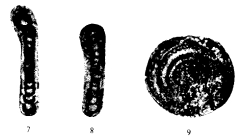
| Intro | | About | | Wiki | | Search traits | | Data explorer | | Literature | | Definitions | | Sources | | Webservices | | Statistics | | Feedback | | Editors | | Log in |
Foraminifera taxon detailsRaphconilia Brenckle & Wahlman, 1996 †
1048374 (urn:lsid:marinespecies.org:taxname:1048374)
accepted
Genus
Eolasiodiscus modificatus Potievskaya, 1962 † accepted as Raphconilia modificata (Potievskaya, 1962) † (type by original designation)
Conilia Brenckle & Wahlman, 1994 † · unaccepted (Junior homonym of Conilia...)
Junior homonym of Conilia Gerlach, 1956 [Nematoda]
marine,
fossil only
feminine
Brenckle, P. L.; Wahlman, G. P. (1996). Raphconilia, a new name for the upper Paleozoic pseudovidalinid foraminifer Conilia Brenckle and Wahlman, 1994. <em>The Journal of Foraminiferal Research.</em> 26(2): 184-0., available online at https://doi.org/10.2113/gsjfr.26.2.184
page(s): p. 184; note: Nomen novum. [details]
Description Emended diagnosis: Test discoidal (with parallel flanks) or slightly lenticular (with biconvex flanks). Proloculus...
Description Emended diagnosis: Test discoidal (with parallel flanks) or slightly lenticular (with biconvex flanks). Proloculus spherical, generally small, followed by a tubular, undivided, planispirally coiled, second chamber. Number of whorls: 5.5–8. Lumina typically at the concavus stage, slightly and regularly increasing in height and width, but involutus stage and angulatus stages are also known in this genus. Wall bilayered with a thin inner dark‐microgranular layer and a thicker hyaline‐pseudofibrous outer layer. As for the archaediscoids, the dark inner layer tends to disappear in the angulatus stage; in contrast, it is more broad and ogival in the involutus stage. Aperture areal, simple, large, at the extremity of the tubular chamber. Residual, ancestral, sutural secondary openings with small sutural bridges are present but not functional, giving the omega‐shaped lumina mentioned by Pinard and Mamet (1998) and Groves and Boardman (1999). Occurrence: Rare in the Gzhelian (Henderson et al., 1995; Groves and Wahlman, 1997). Relatively frequent in latest Gzhelian (= Orenburgian = Bursumian = Newellian) and Cisuralian; then, rare up to the early Wuchiapingian (Lys et al., 1978; Köylüoglu and Altiner, 1989); cosmopolitan. (Yarahmadzahi and Vachard (2017)). [details]
Hayward, B.W.; Le Coze, F.; Vachard, D.; Gross, O. (2025). World Foraminifera Database. Raphconilia Brenckle & Wahlman, 1996 †. Accessed at: https://www.marinespecies.org/foraminifera/aphia.php?p=taxdetails&id=1048374 on 2025-05-21
Date action by
original description
Brenckle, P. L.; Wahlman, G. P. (1996). Raphconilia, a new name for the upper Paleozoic pseudovidalinid foraminifer Conilia Brenckle and Wahlman, 1994. <em>The Journal of Foraminiferal Research.</em> 26(2): 184-0., available online at https://doi.org/10.2113/gsjfr.26.2.184
page(s): p. 184; note: Nomen novum. [details] original description (of Conilia Brenckle & Wahlman, 1994 †) Brenckle, P. L.; Wahlman, G. P. (1994). Conilia, a new Upper Paleozoic pseudovidalinid foraminifer. <em>Mémoires de l'Institut géologique de l'Université de Louvain.</em> 35: 169-176. page(s): p. 170 [details] taxonomy source Yarahmadzahi, H.; Vachard, D. (2019). Moscovian–Asselian (middle Pennsylvanian–earliest Cisuralian) Smaller Foraminifers from the Asad-Abad Section (Sanandaj-Sirjan Zone, Central Iran). <em>Journal of Foraminiferal Research.</em> 49 (2): 107-130., available online at https://doi.org/10.2113/gsjfr.49.2.107 [details] Available for editors From editor or global species database
Description Emended diagnosis: Test discoidal (with parallel flanks) or slightly lenticular (with biconvex flanks). Proloculus spherical, generally small, followed by a tubular, undivided, planispirally coiled, second chamber. Number of whorls: 5.5–8. Lumina typically at the concavus stage, slightly and regularly increasing in height and width, but involutus stage and angulatus stages are also known in this genus. Wall bilayered with a thin inner dark‐microgranular layer and a thicker hyaline‐pseudofibrous outer layer. As for the archaediscoids, the dark inner layer tends to disappear in the angulatus stage; in contrast, it is more broad and ogival in the involutus stage. Aperture areal, simple, large, at the extremity of the tubular chamber. Residual, ancestral, sutural secondary openings with small sutural bridges are present but not functional, giving the omega‐shaped lumina mentioned by Pinard and Mamet (1998) and Groves and Boardman (1999).Occurrence: Rare in the Gzhelian (Henderson et al., 1995; Groves and Wahlman, 1997). Relatively frequent in latest Gzhelian (= Orenburgian = Bursumian = Newellian) and Cisuralian; then, rare up to the early Wuchiapingian (Lys et al., 1978; Köylüoglu and Altiner, 1989); cosmopolitan. (Yarahmadzahi and Vachard (2017)). [details] |

